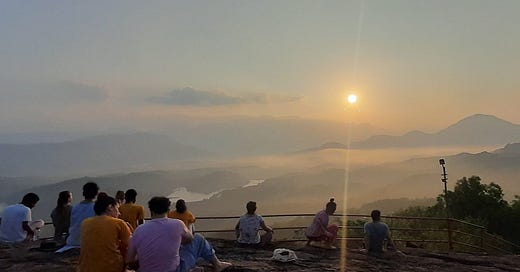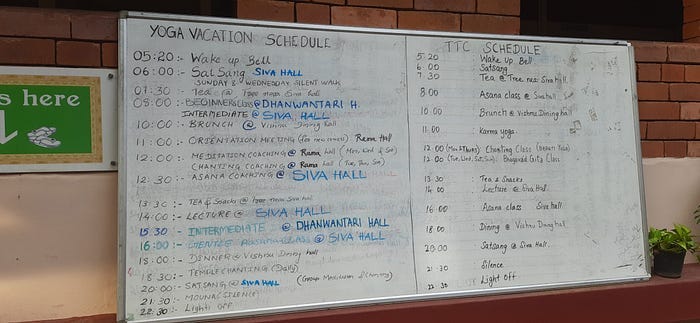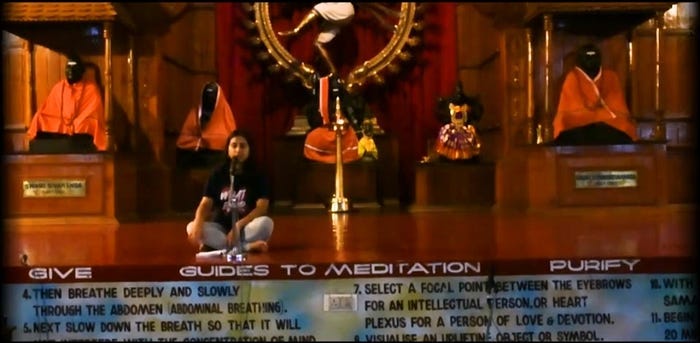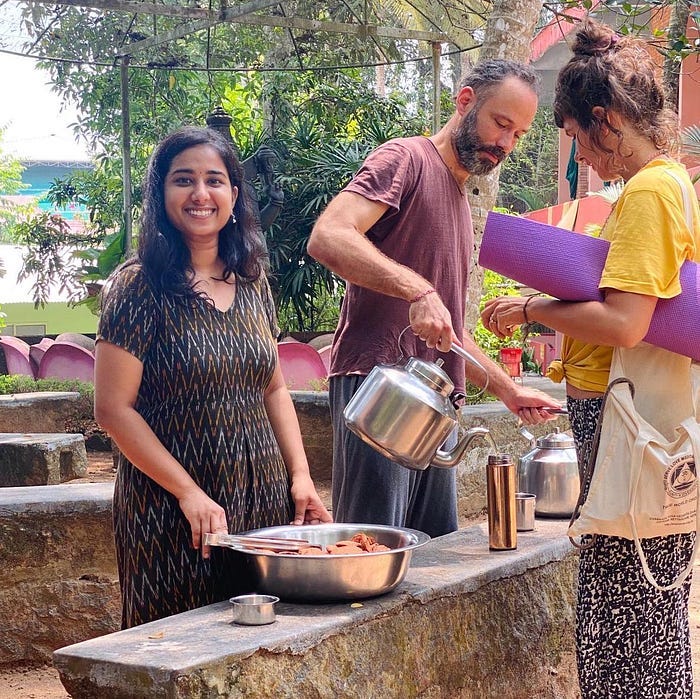The following blog is part of the running series called the ‘well-being journey’ where I discuss my healing journey. I write about my travel journeys, learning from cultural bearers, understanding the life of indigenous communities, and more.
Background: The past few years have been difficult for me in so many ways. I was living in places like Sonipat, & Gurugram (Haryana) and New Delhi. I faced numerous challenges particularly severe health and low immunity issues. The slightest change would cause an illness. I would dread seasonal shifts, travel, stressful events, or heated/ aggressive discussions. Being a sensitive person, it is a lot to cope with. I decided to prioritize my health and take time to learn about Indian cultural systems, and my body, and incorporate well-being practices in my daily life. My work at Leela Life inspired me to study ancient Indic systems such as Ayurveda, Siddha, and Yoga (ancient India had numerous knowledge systems to offer). In the past year of immersing myself in indic systems, I only crave to know more and understand it deeply. To understand Indic systems, I started traveling from my current home in Gaya, Bihar (my father is in the Army and he is currently posted there - 2024). My curiosity to learn about Indian knowledge system continues to take me to places.
🌱
I read the blog by Hari (Founder of Leela Life) titled, ‘Is Yoga only physical postures or something more?’ and was further intrigued to know the yogic systems. The modern view of yoga is limited and focuses on a narrow aspect of the holistic system that yoga is. I started to think about places that would provide a deeper experience and I decided to stay in an ashram in Kerala.
The travel journey that started in March 2024 looks like this:
Gaya, Bihar → Delhi → Bangalore, Karnatkata → Auroville, Tamil Nadu → Trivandrum & Kottayam, Kerala (Current stop- Sivananda Ashram)
The blog has been written to document my journey and how the experiences have helped me overcome my challenges. Selected aspects have been shared below. If you wish to know more, please write to me, and I would be happy to discuss the experience at length.
🌱
As I continued to travel, I reached an important destination for my well-being — Sivananda Dhanwantari Ashram, Trivandrum, in Kerala; established in the year 1978.
Sivananda Ashram, Trivandrum, Kerala
I reached the Sivananda Ashram on 17th April 2024 and was given details about the schedule along with a few essentials including a thali (plate) with a glass, bowl, bedsheet, & mosquito net. A volunteer accompanied me to my room and pointed me in the direction to start my journey at the ashram. It is mandatory to stay for a minimum of 3 days in the ashram, however, I wanted to have a more immersive experience so I stayed for a week.
The daily schedule has a lot of activities and keeps everyone engaged throughout the day. The day starts early in the morning with the ‘wake up bell’ at 5.20 am and the first activity is the Satsung at 6 am. It is followed by a short break, yoga session, first meal, meditation/ chanting session, asana coaching, tea break, lecture, yoga session, dinner, and the evening Satsang. I have tried to share my personal experiences along with a focus on the indic knowledge of yogic traditions to keep things in a better context.
I felt many of the aspects of the ashram reminded me of my home- a typical Brahminical Hindu household. While I have never fully engaged with these activities at home finding them too religious, I have seen my mother perform them with utmost faith. She loves to involve every family member in the rituals, however, I have been nothing but a far-away critic of such practices (Praying, Worship, Aarti, Bhajan), and have often shown my pessimism towards them. It’s not that I dislike these practices, I have a lot of admiration for our ancient Indian systems and firmly believe that are extremely valuable. What often makes me annoyed & move away from the traditions is the lack of knowledge of why these systems were performed in ancient times and what is the meaning of the practices. I often find people performing the rituals blindly without knowing any of them. I find it very disheartening. With this background, I tried my best to be open to new experiences and engage with them at the ashram. Let’s dive below to learn more.
Yoga manifests itself as four major paths, namely Karma Yoga, Bhakti Yoga, Rāja Yoga, and Jñāna Yoga. These four paths are like the branches of a tree or tributaries of a river. They all have the same source and resting place. In essence, they are all the same. The only thing that differentiates them is that there is a certain aspect of the mind involved in a particular path or practice. In Karma Yoga the active aspect of mind is involved; in Bhakti Yoga, the emotional aspect; in Rāja Yoga, the mystical aspect; in Jñāna Yoga, the intellectual aspect.
(Source: Google Arts & Culture)
It was interesting to note that the Sivananda ashram has incorporated all the paths of Yoga into their everyday life. Let’s go deeper into the paths of yoga in the next section
(Note: I will talk about them in the order of activities at the ashram)
Bhakti Yoga
It is the devotional approach of yoga, the one of pure love. This path involves surrendering oneself to God to realize the highest Truth. Aspirants channel their emotions into devotion, developing humility, self-surrender, and the feeling of being an instrument in the hands of the Divine. Bhakti Yoga can be practiced in many ways - praying, chanting, japa (repeating a mantra or name of the Divine), and participating in ceremonies and rituals. Aspirants choose a medium to express their devotion to develop a relationship with the Divine. In the tradition of our Gurus, based on Hindu culture, Bhakti Yoga is practiced at our centers by way of kirtan (chanting the names of the Divine), ceremonies, prayers, rituals, celebrating festivals, and service to the Gurus. At our centers and ashrams, we follow the principle of “Names are many but God is one. Religions are many but the Truth is one”, honoring all religions and all forms of the Divine. (Source: Google Arts & Culture)
The day at the ashram starts with a 1.5-hour long Satsang that includes 30 mins of meditation, 1 hour of chanting, and aarti. I was already dreading being part of the satsang given my past experiences at home. I was further shocked when I saw many Westerners (who were the teachers) doing the mantra chanting and aarti. The accent of the chants was completely different and Westernized. I have grown up learning that the language Sanskrit focuses a lot on its phonetics and the vibration mantra creates is based on the pronunciation of the words. I was thoroughly disappointed with the Aarti experience and didn't know what to do. While I love the idea of diverse people coming to learn Indic knowledge, and attempting to do traditional Indian things, the accent made a huge difference. I wasn’t comfortable with the Satsangs, so I decided to skip most of them due to this reason.
After being at the ashram for 7-8 days, my satsang experience varied depending on who was leading the chanting & aarti. I loved the satsang when the people facilitating were Indians/ locals ensuring the chanting was done in the right manner. It was so peaceful and relaxing.
As we move to the next path of yoga, I want to share an experience where I was inspired to sing a bhajan seeing so many people across the globe learning it. I volunteered to sing one of my favorite bhajans ‘Raghupati Raghav Raja Ram’ during the talent night events conducted every Saturday. The live recording of the bhajan can be seen here.
Rāja Yoga
It is the scientific, step-by-step approach of yoga, the one of mind control. In the practice of Rāja Yoga, the mind is systematically analyzed and various techniques are applied to bring it under control. This process turns the physical and mental energy into spiritual energy. The practice of Rāja Yoga includes Hatha Yoga (yoga postures, cleansing techniques, and breathing exercises) and meditation, and other methods that help one to control body, mind, and senses. Rāja Yoga also includes Ashtanga Yoga (eight limbs), described by Patanjali Maharishi which leads to absolute mind control. (Source: Google Arts & Culture)
In the ashram, Rāja Yoga is followed through the practice of Hatha Yoga and Meditation. As per the schedule, one was required to do 5–6 hours of yoga every day. I was terrified when I saw the schedule and I couldn't think of doing yoga for this long daily. However, I put aside my overstimulated mind and thought to start the process.
The yoga sessions are generally 2 hours (except asana coaching). It touches upon all the 12 asanas part of the Sivananda Hatha yoga tradition.
After completing my first session of yoga, I felt so energized and it didn't feel like 2 hours. I was eager to attend the next session which was about coaching the students- anyone who wasn't able to do certain asanas or had questions was welcome to join the class. I did that. I had the same experience. I enjoyed it.
Note: You can join the sessions as per your needs and capacity. They are not all mandatory to attend.
Understanding the yogic life, the following 5 points are important:
1. Proper exercise (Asanas)
2. Proper Breathing (Pranayama)
3. Proper Relaxation (Savasana)
4. Proper Diet (Vegetarian)
5. Positive thinking & Meditation (Vedanta & Dhyan)
Karma Yoga
“Thy right is to work only, but never with its fruits; let not the fruits of action be thy motive, nor let this attachment be to inaction.” Bhagavad Gita, Chapter 2, Verse 47
It is the yoga of action, the path of selfless service. The practice of Karma Yoga involves performing an action without any expectation of any reward in return, thus renouncing the fruits of the action. A Karma yogi sublimates the ego, purifies the heart, and realizes oneness with all beings by acting selflessly. Karma Yoga can be practiced anywhere, anytime where there is a desire to serve. It depends on the attitude, not the action. (Source: Google Arts & Culture)
Living life in an ashram requires a community and collaborative effort. To put all the teachings into practice, everyone performs Sewa. Everyone including the staff members and guests at the ashram practice Karma Yga by helping with activities such as cooking, serving food, tea & snacks, cleaning, and teaching. I was paired with Thomas- he comes from Normandy, France. Our task was to provide the morning and afternoon tea & snacks to everyone. It was a rich opportunity to serve and learn about all the participants at the ashram. I enjoyed my Karma yoga experience
Jñāna Yoga
It is the philosophical approach to yoga, the yoga of knowledge. Jñāna yoga is the most direct of the four paths, using intellectual inquiry for spiritual evolution. It is practiced through Shravana – listening to the teachings of a guru or study of the scriptures such as Vedas, Manana – reflection on the teachings, Nididhyāsana – meditation on the nature of truth. A jñāna yogi uses the mind to examine its nature through right inquiry (vicāra) and constant self-analysis (vivekā). (Source: Google Arts & Culture)
There is a lecture session every day, done on a variety of topics related to the philosophy of yoga and the study of spiritual texts. While I couldn’t attend most of the session, I was happy that such knowledge was passed on to the current generation.
In addition to the above 4 practices, life in an ashram has the following aspects to it:
Food was served 2 times a day- 10 am morning and 6 pm evening. I had so many doubts about whether I would be able to survive on 2 meals, or would South Indian food suit me.
I had a bad experience during my stay in Kerala during the COVID year, 2020. I was tested positive for COVID-19 and moved into an isolation ward in Kottayam district. It was the hotspot for covid cases in Kerala. I was there for 10 days. For the initial 3 days, I wasn't able to consume South Indian food cooked in coconut oil; had constant severe stomach pain every time I ate the South Indian food. I eventually stopped consuming any solid food and moved to a liquid diet (only lemon water & fruits sent by my family with a lot of difficulty since no movement was allowed in the town & nothing could come inside the isolation ward). It weakened my body but I was able to somehow sustain myself for the rest of the week at the COVID ward.
Due to this experience in my mind, I was terrified and didn't want this to repeat. I wasn’t a fan of the ashram food, however, none of my previous symptoms occurred again. I was relieved.
Note: No photography is allowed inside the dining hall. This is also done to ensure that you focus all your energy on your food without any distractions.
Ashram facilities
There are other facilities at the ashram. One could buy clothes, books, toiletries, and food items at the boutique/store. The Health Hut has many fruit juices, fruits, and some food items that you can get. The Ayurvedic Clinic is where one can go for doctor consultation, massage, or any other health treatment.
Silent Walk (Sunday)
Every Sunday morning, there is a silent walk. Please note that it was a steep hike, would recommend bringing your shoes and signing up for this only if you are in a physically fit condition. I had a difficult time climbing up throughout particularly towards the end at the mountain top. Having said that, it was a beautiful view & very peaceful. Witnessed the rising sun and its magnificence has a magic to it- something I aspire to see every day. I am an absolute sunrise lover as opposed to seeing the sunset. Glimpses of the walk can be seen below.
While ashram life can be seen as strict and restrictive by many, one has to follow a dincharya (daily routine) that suits them. The highlight of the ashram experience was meeting people from across the globe- more than 50+ nationalities. I had the most inspiring conversations with this lovely bunch of people from across the globe. I am so happy to have met the following people including (left to right):

1. Vivian comes from Jamaica & lives in Toronto. I had a great time learning about her interests in food and music. We discussed food ingredients, and recipes, and had so many lovely conversations about life. I remember laughing a lot
2. Tessa comes from Perth, Australia. I had a long discussion about Indian cultural heritage and unique knowledge around food & crafts systems that can help to counter modern-day problems.
3. That’s me- Jyoti :)
4. Sophie comes from the UK and I got to know about her briefly.
5. Uma comes from the UK while her ancestral roots are from Assam, India. I had a lovely time sharing my room, having conversations about our aspirations, & sensitivity (and how it’s challenging but is a superpower too), traveling to Bangalore, and having so many shared experiences throughout the last 2 days.
I think this was the highlight of the experience for me. I was meant to meet them and all the conversations have inspired me deeply to pursue my aspirations. As I continue my journey to learn deeply about Indic systems with a focus on food & herbs, I am beyond grateful for all the support of my loved ones and lovely interactions with people from the universe. It has only helped me strengthen my dreams.
If you wish you go to the ashram, please keep the following in mind:
There are mosquitoes at the ashram. Be prepared for it. You will also get a mosquito net during check-in. You can also buy a mosquito repellent at the store.
You can also carry some snacks or fruits. Food is offered twice a day so one tends to be hungry at odd times. There is a health hut within the ashram so one can get fruit salad or fresh juices there as well.
Carry loose clothes for yoga and general stay at the ashram. Tight-fitting clothes are discouraged at the ashram. You may be asked to change by the staff members if it is found to be going against the rules.
You can buy clothes or food items at the ashram store. However, they are expensive and may not suit your preferences.
Coming out of the ashram
The ashram experience for me was a mixed bag. I miss the rhythm of the chanting during aarti. It’s still humming in my head. I am trying to develop a practice to sit for 10-15 minutes and chant for myself. It has been a very relaxing and joyful experience. I found the yoga sessions helpful too. I wish more details or knowledge were shared in the sessions.
There was also a sense of confusion and feeling of loss towards our Indic systems. The authenticity is fading away but I see a small group of people is still interested to understand the traditional knowledge. I hope that it helps to keep the systems alive and thrive.
Overall, I would say I had many positive experiences and am happy that I chose to stay there.














Thanks for sharing this Jyoti. I was planning to go to Sivananda Ashram as well, couldn't find much details of what happens there online anywhere else. This is super helpful. Hope you are getting better and heal soon. Sending lots of hugs your way!
Hey, Vishal again!! Although I have visited Kerala numerous times, your insights and experiences have truly piqued my interest and made me eager to explore the state even more.The stories about the people you met from various parts of the world were delightful. It was heartwarming to read about the bonds you formed and the enriching conversations you had. Also appreciate your honesty about your initial skepticism towards certain practices and how you gradually embraced them. Your journey from a far-away critic to an active participant in satsangs and bhajans was heartfelt and relatable.
Keep writing Jyothi!!!